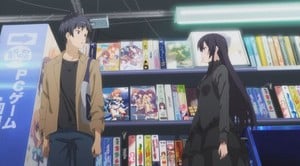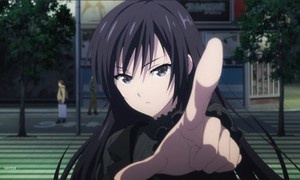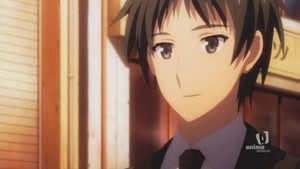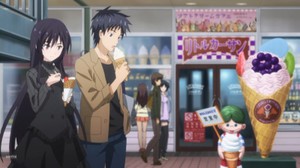The Winter 2016 Anime Preview Guide
Girls Beyond the Wasteland
How would you rate episode 1 of
Girls Beyond the Wasteland ?
Community score: 3.5
What is this?
 Buntaro Hojo feels adrift in the wilderness. His best friends Atomu and Yuka seem to have so much energy every day, with big dreams for their future and every moment full of possibility. But even after stretching his creative muscles by adapting a classic yuri story for the school play, Buntaro's heart is left unfulfilled. Still, his efforts haven't gone unnoticed. A peculiar girl named Sayuki Kuroda appears before him the next day, dressed all in black and downright desperate for his assistance. She wants him to write the scenario for her debut blockbuster bishoujo game (with yuri elements), saving her and her collaborators from the wasteland of mediocrity. Buntaro isn't sure what to think of this weird dark lady at first, but her dream is surprisingly infectious. After all, he doesn't have anything better to do, right? Girls Beyond the Wasteland is based on a visual novel and can be found streaming on The Anime Network and Hulu, Thursdays at 9:30 AM EST.
Buntaro Hojo feels adrift in the wilderness. His best friends Atomu and Yuka seem to have so much energy every day, with big dreams for their future and every moment full of possibility. But even after stretching his creative muscles by adapting a classic yuri story for the school play, Buntaro's heart is left unfulfilled. Still, his efforts haven't gone unnoticed. A peculiar girl named Sayuki Kuroda appears before him the next day, dressed all in black and downright desperate for his assistance. She wants him to write the scenario for her debut blockbuster bishoujo game (with yuri elements), saving her and her collaborators from the wasteland of mediocrity. Buntaro isn't sure what to think of this weird dark lady at first, but her dream is surprisingly infectious. After all, he doesn't have anything better to do, right? Girls Beyond the Wasteland is based on a visual novel and can be found streaming on The Anime Network and Hulu, Thursdays at 9:30 AM EST.
How was the first episode?

Hope Chapman
Rating: 1.5
What's ugly, cheap, boring, derivative, and chooses to end on the sole plot point it should have started with? It's Girls Beyond the Wasteland! And what a wasteland it is...
It's no exaggeration to say that this entire episode could have been compressed down into five or six minutes of a show with decent pacing, but pacing probably wasn't the first thing on the staff's minds when they were struggling to animate this low-effort little nothing of a VN adaptation. This is definitely the most flat and generic-looking show of the season so far, with How to Draw Anime 101 designs that constantly go off-model if the poor things are forced to turn even a slight degree away from either dead-on or in profile. (Don't worry, they go off-model dead-on and in profile sometimes too.) It's especially weird because the series' OP song is extremely fluidly animated, some parts of it might have new drawings every frame, but apparently none of that leaked into the show itself.
Still, shoddy ugliness has never kept me from appreciating a good story, but Girls Beyond the Wilderness doesn't have that going for it either. "One guy and a passel of girls make a visual novel together" is fast becoming its own cliché, and this show is a pretty far cry from the comparatively charming and handsomely produced Saekano (of the same premise) that aired exactly a year ago. Girls Beyond the Wilderness takes forever to get to the obvious point, and the protagonist restates his boring non-raison d'etre a few dozen times ("gosh, I don't know what I want to do with my life!") before the show finally decides to introduce his gothic cipher of a love interest. Then they spend the show's entire second half on a "date" where she coyly restates what the audience already knows: she's "testing" his social skills when interacting with girls to see if he'd be good at writing a dating sim. It's a lame idea that's been done many times before, and this show seems really proud of itself for spending a painfully long amount of time on it, while doing absolutely nothing interesting on a visual level to compensate for the plug-n-play dialogue.
Girls Beyond the Wasteland isn't going to be the worst of the season by any means, because there isn't anything particularly offensive or embarrassing about it. At the same time, I can't think of an anime that had less reason to be made (again) than this one. Unless it magically comes to life in later episodes, I can't see anything about this effort that wasn't done ten times better by other otaku-aimed meta-VN stories. Totally forgettable, dry as dust, just check out Saekano, The World God Only Knows, or any number of better iterations on these ideas instead, unless you're looking for a strong sedative in anime form.

Theron Martin
Rating: 4
Review: I tried to go into this series as blind as possible, so I didn't know what the basic premise was when I watched the first episode. Even without knowing that, though, I had the unmistakable impression that I was watching some variation on last winter's Saekano: How to Raise a Boring Girlfriend. It turns out to be an accurate one, too, although this version is coming from the angle of the guy being recruited for the process by a girl rather than the guy recruiting the girls for a project he wishes to create. Will that be enough, though, to give this series a different flavor?
The first episode is inconclusive on that point. Certainly it does not go for the self-referential gimmick start that Saekano did, as it spends the entirety of its time setting up the characters and scenario. Buntaro is portrayed as an all-around upstanding young man: he's hard-working, a problem solver, and seems to get along well with just about everyone, though that (thankfully) isn't done to overkill. He also shows himself to be observant and open-minded enough to adapt a yuri play without batting an eye at it and comfortable dealing with girls; the only time that Sayuki Kuroda throws him off is when she confronts him in the men's restroom, and that would throw just about any guy off. However, he is also suggested to be directionless, and his home life seems to be a lonely one even though he has good friends who come to hang out. Hence we get a very good sense of where he is going to be coming from as the series moves forward, as well as an inkling of how Sayuki might succeed at drawing him into her bishoujo game-making scheme, and that grounds him better than a lot of similar characters out there.
Contrarily, Sayuki is more typical as the mysterious, earnest, long-dark-haired beauty of a loner. However, the writing balances that out by showing her being at least a little clever: the “date” is hardly a frivolous exercise but her tool to evaluate whether or not Buntaro has a good enough understanding of interpersonal interactions to write a convincing game scenario. She is already showing her moves to be carefully-calculated in a reasonable fashion. That last part is, I feel, especially important since it is also so often overdone.
In fact, that's exactly where I think that Girls Beyond the Wasteland claims some uniquely meritorious ground. Many of the elements present here give the impression of this being just another light or visual novel adaptation – and who knows, maybe it will end up being that – and that does, indeed, leave a negative surface impression. However, the way those elements are being handled in a controlled and moderated fashion is what makes this opening episode stand out at least a little. Sure, Buntaro's friends sneak along to spy on him when he's out and about with Sayuki, but they remain unobtrusive in the background; the writing does not feel a need to unduly focus on them or play them up for comedy value. Yes, Yuuka is the overly-energetic girl, but she is not done to excess and even has an introspective moment. It doesn't (yet) beat you over the head with what anyone's problems are or engage in toss-away fan service, either. Even the yuri element in the initial play is portrayed as just another romance. How extraordinary this all is for a series like this is very easy to underestimate.
Director Tatsuya Sato has a proven ability to milk more out of a concept than it seems like it should be worth (Armitage III, Selector Infected WIXOSS, Steins; Gate), so I'm definitely willing to trust him here. Though not spectacular, the artistry and music are good enough, too. I can see this being a sleeper title in a qualitative sense and will definitely give it time to prove itself.

Nick Creamer
Rating: 2.5
Following in the footsteps of last year's Saekano, Girls Beyond the Wasteland presents us with one more story of a group of teens working to create a bishoujo game. However, that's about as far as that comparison can stretch; writing-wise, the two could not be more different. Saekano was one of those frustrating light novel-based shows where every single character talked as if they were aware they were in an anime, and that everything they were doing and saying was anime-esque. In contrast, Girls Beyond the Wasteland is one of the most weirdly grounded shows I've seen in a while.
For the first half of this episode, pretty much everyone in Girls Beyond the Wasteland talks like a regular human being. Not even “in comparison to self-aware light novel shows” - the early scenes here are really just the protagonist Buntarou jumping between a variety of part-time jobs, and then spending a fairly mundane night hanging out with his two friends Yuuka and Atomu. They talk about the daily events and complain about career forms and eat snacks. It's not particularly thrilling content, but it's actually kind of refreshing to see a show with such an even-keeled affectation, and Buntarou legitimately comes off like a regular guy.
The introduction of Buntarou's black-haired classmate Kuroda changes all that, as she is unabashedly an Anime Character. Speaking in riddles and maintaining a classic “cold beauty” aesthetic, she brings this briefly unusual show back to its expected genre space, as she challenges Buntarou to help her create a bishoujo game. The shift in tone seems to imply this first episode was likely a fake-out; Kuroda and a barely-introduced red-haired girl are the two girls highlighted by the opening song, so it's likely the show will fall into standard club and possible romance shenanigans soon enough. But based on this first episode, there just isn't enough info to say what tone the show will actually strike.
Outside of its somewhat weird writing, Girls Beyond the Wasteland is not an impressive production. It's really the character designs that draw attention visually, and not because they're good, but because they're so very bland. This show's characters basically all look like default “draw an anime character” first attempts, with Buntarou himself being the blandest of brown-haired main characters. Girls Beyond the Wasteland's first episode was a little too structurally odd to be pinned down quite yet, but there also wasn't really much of a reason to keep watching.

Rebecca Silverman
Rating: 1.5
I'll preface this by saying that I have never been a fan of aggressively weird characters. You know the type – deliberately quirky as they pursue the hero, confusing him with their actions and words as they seek to fulfill their own, oftentimes selfish, goals. Kuroba is one of those heroines, and even if you don't know what the premise of Girls Beyond the Wasteland is, she makes it very easy to figure out: the girl acts like she's a choice in a dating sim, or bishoujo game, at all times. In fact, some of her actions, such as confronting hero Bunta in the boys' room or forcing him to decide what they're going to do on their “date,” seem so forced that you have to wonder if her plans are worth acting so deliberately unreal.
The answer to that, I suppose, lies in how enticing you find the game-creating goal of the show's plot. On one level, Kuroba's got a very good point – a good bishoujo game can spawn plenty of lucrative spinoffs and propel its scenario writer to stardom, or at least financial comfort. But her way of going about it feels like the guy who dresses up as Super Spider Batman for the comic convention and then doesn't understand why people are shying away from him: she's so overplaying her assumed role that it's almost laughable, or at least off-putting. It certainly feels like Bunta is having that reaction to her, although since there are more episodes we must assume that his feelings will change. And even if they don't he's such a hard-working overachiever that it feels as if he's a caricature as well – he writes plays, he does apparently everything but cook at his part-time job, and he helps out in class and diffuses tense situations. Meanwhile his friend Yuka is so hyper-enthusiastic about everything that she needs a bucket of cold water dumped on her to make her sit still for twenty seconds. While I appreciate the gimmick that all of the characters who will likely be involved in Kuroba's money-making scheme are all essentially game characters themselves, it's definitely an idea that plays better on paper than in practice, with the episode coming off as oddly confusing and not a little irritating.
That there's something very generic about the character designs and the dialogue doesn't help, and there's a tendency towards Bunta looking a bit cross-eyed in most of his scenes. There has been an effort to make people look different from each other – that's not where the “generic” comes in – but really the best that this pulls off is “serviceable.” As I said, the story sounds much more entertaining than I found the episode to be. At this point it feels like promise squandered, a cookie cutter group in a basic story about a genre that doesn't get a ton of variation as it is.

Lynzee Loveridge
Rating: 4
Hardworking Buntarō and his supporting cast of potential girlfriends are forming a club to make a bishojo game. In summary, this isn't a complicated premise or even a groundbreaking one, but Girls Beyond the Wasteland succeeds despite this because its characters are likable. If a show is going to stick within the well-tread “club activities” schtick, then the focus needs to be on writing characters and humor that aren't obnoxious.
Buntarō's introduction as a reliable, friendly guy is a good start. He manages the tasks as a part-timer at a busy ramen restaurant, helps other businesses in the area, and supports his friends dreams like the talented actress Yūka. He's floundering though, because despite how busy he is, the guy has no set future goals of his own. He dabbles at writing stage plays but that's about it. The first half of the episode's runtime is dedicated to hammering home Buntarō's day-to-day and what kind of person he is. By the end of the episode, I really felt like I had a good sense of his personality, which isn't often the case in these sorts of rom-com harem shows where the protagonist's personality is simply summed up as “nice.” Buntarō is nice but it isn't situational so as to maintain the attraction of Girl A, B, C in her respective episode.
Yūka is also written well. Yes, she's the enthusiastic almost smothering childhood friend type, but the episode eschews giving her thinly-masked jealousy when Buntarō goes on a date. Instead, foreshadowing is cast about her own fear of time, or youth, slipping away. Sayuri, too, is initially given the impression of being a scowling, cold tsundere. I was fully expecting her to be insufferable, yet somehow cajole the well-meaning Buntarō into making her game with her while treating him like crap for the rest season. Her real personality, the socially awkward otaku, again isn't unique. But Sayuri is still a likable lead for her drive and unintentionally cute affections.
I was expecting a fair amount of fanservice, too. This is show about making otome games is, in turn, based on an otome game after all. There's zero. Zip. Zilch. None. Yūka tackles Buntarō' on the stairs? There's shorts under her skirt and the camera doesn't pan and zoom on her butt. Her boobs don't end up in his face. We never see any panties, or camel toe, or accidental cleavage. The dolphins do not, in fact, spray water on Sayuri during her date with Buntarō to reveal her bra beneath her blouse. Is this a trick to lull me into a false sense of security?
Girls Beyond the Wasteland is an enjoyable diversion thanks to a well-established cast of likable characters. They seem like friends I would have enjoyed being around in high school. If I'm going to spend 25 minutes each week in an anime clubroom, the most I can ask for is characters I'll actually like.
discuss this in the forum (428 posts) |
this article has been modified since it was originally posted; see change history
back to The Winter 2016 Anime Preview Guide
Season Preview Guide homepage / archives